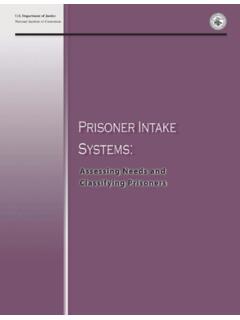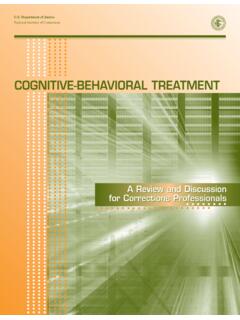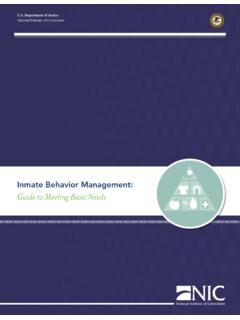Transcription of A Guide to Preparing for and Responding to Jail Emergencies
1 Department of Justice National Institute of Corrections A Guide to Preparing for and Responding to Jail Emergencies Self-Audit Checklists Resource Materials Case Studies Department of Justice National Institute of Corrections 320 First Street, NW Washington, DC 20534 Morris L. Thigpen Director Thomas J. Beauclair Deputy Director Virginia A. Hutchinson Chief, Jails Division Jim T. Barbee Project Manager National Institute of Corrections A Guide to Preparing for and Responding to Jail Emergencies Self-Audit Checklists Resource Materials Case Studies Jeffrey A. Schwartz, Cynthia Barry, LETRA, Inc. Campbell, CA October 2009 NIC Accession Number 023494 This document was funded by cooperative agreement number 06J48 GJJ5 from the National Institute of Corrections, Department of Justice. Points of view or opinions stated in this document are those of the authors and do not necessarily represent the official opinion or policies of the Department of Justice.
2 Cover photos: Left photo Photodisc Illustration/Getty Images. Middle photo Shutterstock Images. Right photo Photodisc Illustration/Getty Images. Contents v vii Acknowledgments ..ix Section 1: 1 Which Jails Will Benefit From These Self-Audit Materials? .. 3 Development of This 13 Section 2: Conducting an 15 Purpose and 17 Preliminary 21 How To Use the Self-Audit Checklists .. 27 Section 3: emergency Preparedness Self-Audit Checklist for Smaller 37 Section 4: emergency Preparedness Self-Audit Checklist for Larger Jails .. 53 Section 5: Resource Materials .. 117 Leadership Issues During 119 Prevention of Jail 127 emergency 139 Section 6: Case 153 Maury County Jail 155 Disturbance and Escape at a New Direct Supervision 161 Hurricane Andrew and the Florida Department of 169 Riots at Camp Hill State Correctional 173 iii Contents (continued) Exhibits Exhibit 6-1: Maury County Jail.
3 155 Exhibit 6-2: Rensselaer County Jail .. 162 Exhibit 6-3: Camp Hill State Correctional Institution .. 174 iv The National Institute of Corrections (NIC) has maintained a substantial focus on emergency preparedness for prisons. In 1981, NIC first offered seminars on dealing with major crises to prison administrators throughout the country. Even before that, NIC had provided technical assistance on emergency preparedness to vari ous state prison systems. In the wake of some of the worst riots, hostage situations, and natural disasters, NIC has often been asked to provide specialized expertise in conducting indepen dent, critical incident reviews (also referred to as after-action reports ), usually in the form of technical assistance projects. In 1996, NIC published Critical Analysis of emergency Preparedness: Self-Audit Materials. An updated and expanded version of that Guide was published in 2005 as A Guide to Preparing for and Responding to Prison Emergencies : Self-Audit Checklists, National Survey Results, Resource Materials, Case Studies.
4 Both of those publications were intended to provide prison managers and administrators with comprehen sive, detailed checklists with which they could evaluate the readiness of a prison or entire state department of corrections for a major emergency or large-scale crisis. NIC also sponsored a series of interrelated seminars providing hands-on training to prison administrators in the use of these new audit instruments. Jails have always shared many of the same con cerns and needs as prisons with regard to emer gency preparedness. However, until recently, Foreword jails have placed less emphasis on emergency preparedness than has been true of prisons. Clearly, large-scale crises and major emergen cies represent the same kind of catastrophic risks to jails that they do to prisons. In fact, what I wrote on the subject more than 10 years ago in the Foreword to NIC s Critical Analysis of emergency Preparedness: Self-Audit Materials1 applies to today s jails equally well: emergency preparedness is a crucially important every correctional institution.
5 Large-scale inmate violence or a natural disaster can threaten the lives of both the institution staff and inmates. In hours, a major emergency can of millions of dollars and result in many years of litigation. The negative publicity surrounding a major institutional crisis can also be over whelming and almost interminable. emergency preparedness is often not afforded the priority that it needs and deserves. In some cases, this may be due to complacency. In other cases, it hap pens because establishing a comprehen sive system of emergency preparation and emergency response is not easy. It requires budget, time, equipment, inter agency coordination, and long-term management attention. 1 Jeffrey A. Schwartz and Cynthia Barry, Critical Analysis of emergency Preparedness: Self-Audit Materials (Washington, DC: Department of Justice, National Institute of Corrections, 1996). v Over the past several years, a number of fac tors both internal and external to jails have resulted in a burgeoning appreciation for emer gency readiness.
6 The events of September 11, 2001, have made terrorism a local as well as an international issue. High profile escapes, large-group disturbances, staff murders, and hostage incidents have served to put jails interminably at the top of the news and remind those of us in this field of the risks inherent in operat ing any correctional institution. Moreover, an executive order signed by the President has made it mandatory to familiarize staff in all cor rectional agencies with the National Incident Management System (NIMS). The most graphic evidence of the importance of emergency pre paredness to jails lies in the stark video footage of events surrounding Hurricane Katrina, partic ularly with regard to the problems encountered in attempting mass evacuation of the jails in southeast Louisiana. For all the reasons outlined above, and perhaps more, there is a newfound wave of interest in emergency preparedness among this country s jails. That is, in itself, a very positive development because few issues relate as directly to community safety, staff safety, and inmate well-being as does emergen cy preparedness.
7 It is NIC s hope that this publication will be broadly useful to jails in planning for cri ses, Emergencies , and natural disasters and in developing the appropriate response capacities to cope with these events where they cannot be prevented. Morris L. Thigpen Director National Institute of Corrections vi After working with jails and prisons across the United States and Canada for more than 35 years, with a substantial amount of that work centered on emergency preparedness, we find that several conclusions have become apparent. The most positive is the developing apprecia tion for the emergency preparedness on the part of jails that Morris L. Thigpen describes in the Foreword. There are a number of other conclu sions that are more challenging or more trou bling. Jails are well behind prisons in this area. Today, most state departments of corrections and most individual prisons have thorough, extensive, and detailed emergency plans and there is staff training on those plans.
8 There are emergency specialists ranging from negotiators to public information officers to tactical teams, and there are drills, exercises, and specialized emergency equipment. Certainly, some jails carefully and thoughtfully prepare for Emergencies . However, in too many jails, preparation is seriously substandard or lacking altogether. Some jails have emergency plans or manuals that are badly out of date or so poorly developed in the first place that they would be of little or no use to staff in a real crisis. Further, staff often have no training or familiarity with those plans; in a fast-developing major emergency , staff would have no chance to read the plans. Instead, they would simply rely on experience and instinct and hope for the best. The evidence that most jails are inadequately prepared for major Emergencies is beyond dispute, and it extends to a very broad range Preface of areas. For example, most administrators in corrections and law enforcement now acknowl edge that staff and their families will predict ably have extraordinary needs during and after major Emergencies .
9 The aftermath of Hurricane Katrina underscored this conclusion. Yet many jails have no realistic plans for dealing with hos tages after release, assisting their families dur ing an incident, or addressing the gamut of other staff and staff family issues that go far beyond counseling for posttraumatic stress. There are several reasons why many jails are poorly prepared for major Emergencies . One is that some jails simply believe it can t hap pen here. Of course, when it does happen, it is too late. A second reason is that most jails are sheriff s jails. The sheriff s department may have a well-trained, professional correctional emergency response team (CERT) or special weapons and tactics (SWAT) team and well-developed contingency plans for various kinds of large-scale problems in the community, but the jail may be an afterthought, or there may be an assumption that if a serious problem occurs within the jail, the patrol side of the organiza tion will handle it.
10 Also, if the patrol and inves tigative divisions of the sheriff s department are the prestigious assignments and the jail is the red-headed stepchild, then an issue as techni cally complex and demanding as emergency preparedness is unlikely to be near the top of anyone s list. A third reason emergency preparedness in jails is not what might be hoped for nationally vii involves the task itself. Good emergency pre paredness is neither quick, nor cheap, nor easy. In an era of ever-tightening resources, it is diffi cult to divert any of those scarce resources from day-to-day needs, even though everyone rec ognizes that a badly handled major emergency can negatively define an entire organization for many years. Not all the news about emergency preparedness is bad. There are more positive aspects than may be apparent, some of which are subtle. First, although some kinds of jail Emergencies cannot be prevented ( , tornadoes or floods), other kinds can be ( , disturbances and escapes).















